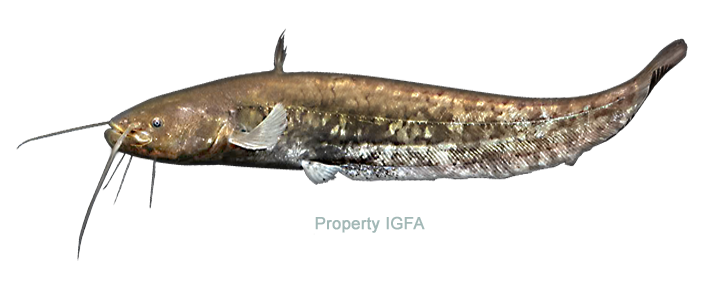Game Fish Identification Reference Guides
Wels
(Silurus glanis)
(Silurus glanis)

Linnaeus, 1758: SILURIDAE FAMILY; also known as wels, weller, siluro, som, European catfish, sheatfish, malle, Danube catfish
This species occurs naturally or has been introduced to most of central and eastern Europe, also found throughout Asia Minor and central Asia, England, Tunisia and Algeria. The wels mainly inhabits deep-water lakes and rivers, though it enters brackish water in the Baltic and Black Seas and spawns in the salt water of the Aral Sea.
Typical of the family, its body is scaleless. The anal fin is very long and three pairs of barbels, one on the upper and two on the lower characterize the jaws. The speckled body is brown or gray-black in color. The wels is one of the largest of all freshwater fishes. It is said to exceed 16.4 feet (500 cm) in length and up to 675 lbs (306.0 kg) in weight.
Wels stay close to the bottom during the day, seeking cover in hollows or buried in the soft bottom it prefers. This species is active at night, often in quite shallow water. It is a voracious predator, feeding mainly on fish, frogs and crayfish. Occasionally it takes voles and waterfowl. Tales of it attacking and drowning dogs and even children, but these are based on hearsay, rather than observation.
Angling for wels is highly valued sport both for its size and skill required. The species can be caught by ledgering with live or dead fishes, by surface float fishing using a large float or even by trolling. Spinners, plugs and imitations of mice and frogs are also frequently used.
The orangish flesh is practically boneless and very tasty, but large specimens tend to be too greasy. The eggs are used as caviar by themselves, or to adulterate true sturgeon caviar
This species occurs naturally or has been introduced to most of central and eastern Europe, also found throughout Asia Minor and central Asia, England, Tunisia and Algeria. The wels mainly inhabits deep-water lakes and rivers, though it enters brackish water in the Baltic and Black Seas and spawns in the salt water of the Aral Sea.
Typical of the family, its body is scaleless. The anal fin is very long and three pairs of barbels, one on the upper and two on the lower characterize the jaws. The speckled body is brown or gray-black in color. The wels is one of the largest of all freshwater fishes. It is said to exceed 16.4 feet (500 cm) in length and up to 675 lbs (306.0 kg) in weight.
Wels stay close to the bottom during the day, seeking cover in hollows or buried in the soft bottom it prefers. This species is active at night, often in quite shallow water. It is a voracious predator, feeding mainly on fish, frogs and crayfish. Occasionally it takes voles and waterfowl. Tales of it attacking and drowning dogs and even children, but these are based on hearsay, rather than observation.
Angling for wels is highly valued sport both for its size and skill required. The species can be caught by ledgering with live or dead fishes, by surface float fishing using a large float or even by trolling. Spinners, plugs and imitations of mice and frogs are also frequently used.
The orangish flesh is practically boneless and very tasty, but large specimens tend to be too greasy. The eggs are used as caviar by themselves, or to adulterate true sturgeon caviar












